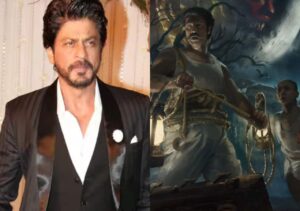
“Math is truth,” says Mark Hamill’s aged patriarch, Albie Krantz, in Mike Flanagan’s recent adaptation of Stephen King’s The Life of Chuck. “It’s used in everything. In every job. In every facet of life on this planet.” Albie is an accountant, and he’s explaining to his orphan grandson, Chuck (played by Benjamin Pajak in this scene), that while the young man’s dreams of being a dancer are an absurd long shot, he could become an accountant and change people’s lives in more meaningful ways. “The world loves dancers, but it needs accountants,” Albie says.
Hamill delivers this monologue with real passion, his raspy voice quivering with sincerity. The movie, we suspect, believes what Albie says. But then the character’s voice drops another register and a sadness settles over his words. He explains, somewhat ominously, that things like statistics and probability can essentially tell the future. Later, we will learn that in the forbidden cupola of Albie’s Victorian home, Albie and Chuck can see visions of their deaths as well as those of people close to them. In the last scene, a teenage Chuck glimpses his own final moments later in life, lying in bed riddled with cancer. (The film moves backward in time, so the viewer has already seen his untimely death at 39.) He vows to forget about the vision and live his life to the fullest. So he becomes… an accountant.
Wait, what? Don’t characters who feel the cold, clammy hand of mortality creeping up their backs tend to do something more creative, more unconventional with their lives? Shouldn’t Chuck become a world traveler or an artist or something? In truth, Flanagan’s film presents a more nuanced view of what it means to live a life. But it also fits into a recent trend of movies that feature characters who are struggling against the force of metrics ruling their lives.
It’s not just the movies, either. Everywhere we look, numbers reign supreme. Metrics determine our life and work in ways that were inconceivable ten or 15 years ago. Worker productivity is defined by reams of data. Poll-tested politicians deliver poll-tested answers about poll-tested questions (and then wonder why everyone hates politicians). Sports discourse is dominated by contract numbers, player stats, shot percentages, betting lines. The books we read, the movies we watch, the shows we consume — more often than not, they’ve been funneled to us by algorithms designed to give us more of what we already know and like. The film industry, of course, experiences this phenomenon every day, as moviegoers are inundated with news about a film’s budget before it’s even released. Then there’s the Tomatometer, the Metacritic score, the Letterboxd average. Once you turn art into content, you can measure it, gamify it, quantify it, reduce it, maybe even discard it. You don’t need to see the movie to play the numbers game.
In Celine Song’s Materialists, which came out in June, Dakota Johnson’s Lucy Mason works for a highly data-driven New York dating service, where the right match can be found by checking a bunch of boxes: height, weight, age, income bracket. When she starts seeing the hyperwealthy, handsome, and generous Harry Castillo (Pedro Pascal), she tells him with clear-eyed serenity that she’s a bad match for him. “You can do better than me,” she says. “You know how to do the math, don’t you?” Numbers are unforgiving even for someone who looks like Dakota Johnson. “If you marry a 25-year-old, in ten years she’ll look like me,” she tells Harry. “If you marry me, in ten years I’ll look like my mother. At the end of the day, the math doesn’t add up.”
Wes Anderson’s The Phoenician Scheme takes a more playful approach. In that film, the audience is actually asked to do some ongoing calculations as we track international construction tycoon Zsa-Zsa Korda (Benicio del Toro) on a mission to convince various partners to put up more money for an immense project. A recent trade war has raised the price of a key building ingredient. An onscreen tally keeps count of Zsa-Zsa’s progress, informing us of the gap in his budget, how much money he needs to fill it, and how much has been pledged; it’s up to us to figure out whether he’s getting close. “I’ve asked a lot of my audience in many ways,” Anderson told me when I spoke with him about this earlier this year, “but this is the first time it goes to math. But in a fun way, I think.” In fact, the math winds up not mattering — because Zsa-Zsa’s project runs headlong into his irredeemably evil and irrational brother, Nubar (Benedict Cumberbatch), in a scene in which the characteristic precision and careful composition of Anderson’s visual style give way to unhinged, handheld, snarling chaos. By the end, our protagonist has given up his dreams of material wealth. He’s broke, running a small bistro with his daughter. And he’s happy, maybe for the first time in his life. Believe it or not, Lucy Mason might be proud: At the end of Materialists, she’s backed off from her math-obsessed ways, ditched her unicorn gazillionaire boyfriend, and made off with her struggling-actor ex, John Finch (Chris Evans). She also seems happy.
We can see this battle between numbers and humanity playing out across our blockbusters, too. In Joseph Kosinski’s racing drama, F1, veteran driver Sonny Hayes (Brad Pitt) defies the data and races in wild, unpredictable ways. When Sonny first joins his new racing team, we see the cars zooming around the track as numbers and readouts on a screen. His teammate and occasional rival, rookie driver Joshua Pearce (Damson Idris), is deeply enmeshed in the machinery of the vehicles; Kosinski initially films Joshua as if he’s part of the car. Joshua does things by the book and by the numbers. In contrast, Sonny rejects the advice of the technicians looking at screens, opting instead to play mind games with his opponents on the track. The cutting-edge cars he drives have been engineered with great precision, but they need the real-life, experiential feedback and inventiveness only flesh-and-blood drivers can provide.
Individually, none of these films are necessarily doing anything new. F1’s man-versus-machine approach is a variation on Rocky IV’s formula of old-school underdog Rocky Balboa training with logs in the mountains and on snow and technologically enabled Soviet Übermensch Ivan Drago. Kosinski’s own Top Gun: Maverick presented a similar contest between human ingenuity and high-tech predictability. The last two Mission: Impossible films have shown Tom Cruise & Co. going full analog to defeat the Entity, an all-powerful AI engine that has gamed out the future and decided humans must go.
But there’s something more at play here, too. Look no further than the quartet of disrupter types who gather at a compound in the mountains of Utah in Jesse Armstrong’s dystopian satire Mountainhead, released in May. In one of their macho rituals, they write their net worths on their chests in lipstick, even though they pretend not to care all that much about it. These sociopathic billionaires have gathered for a friendly weekend poker retreat. But the rest of the world appears to be burning, fueled by their disinformation-spreading social-media platforms and AI engines. So instead these men spend their time staring at their phones, casually reshaping the planet into a tech-enabled transhuman utopia.
Are these figures just slightly heightened versions of the business-casual douchebags who’ve been running our lives for a generation? Sure, but there’s something else that’s chillingly familiar about them. In their alienation, in their addiction to information (however inaccurate), in their conviction that this gives them power and understanding, we may recognize ourselves. Maybe the reason why we’re witnessing so many metrics on our screens is because these things have become second nature to us. The movies aren’t warning us about seeing ourselves as numbers so much as they are reflecting the sad simple fact that we already do.
I keep thinking about the ending of The Life of Chuck. Before he closes the door on that vision of his own death, a teenage Chuck makes himself a promise. “I will live my life until my life runs out,” he thinks to himself. “I am wonderful, I deserve to be wonderful, and I contain multitudes.” It’s a riff on an ongoing reference in the film to Walt Whitman’s poem “Song of Myself.” The film posits, through its odd, backward structure, that while Chuck might have given up his dreams of dance and become a humble accountant, his mind, like all of ours, is filled with a whole inner universe built out of people and things he had encountered over the course of his life — all unquantifiable and unmeasurable, beyond the reach of that magic math and those powerful numbers. Chuck’s grandfather might have told him that numbers are beautiful, ruthless, true, and predictive, and he might have been right. But Albie was also a sad drunk, a good man haunted by the deaths he’d seen. Chuck refuses to change or break himself because of his vision. He proceeds to have a happy life unbound by any urgency about his eventual demise. In other words, he understands the numbers but doesn’t let them define him. He transcends the math. Needless to say, like all the others, the film is a fairy tale.
Related
- Wes Anderson Explains the Darkness at the Heart of His Films
- Materialists Is an Inert Misreading of Modern Romance
- Don’t Be Surprised If The Life of Chuck Breaks You
Everywhere we look, numbers reign supreme — including in many of this year’s biggest movies.

































































